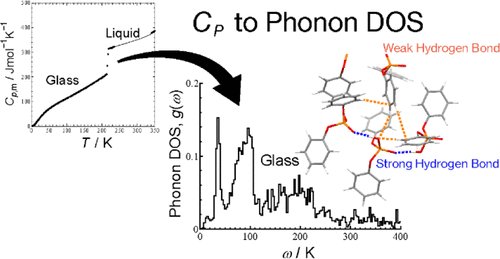当前位置:
X-MOL 学术
›
J. Phys. Chem. B
›
论文详情
Our official English website, www.x-mol.net, welcomes your
feedback! (Note: you will need to create a separate account there.)
Determination of Phonon Density of States from Constant-Pressure Heat Capacity Data of Soft Organic Materials in the Glassy and Crystalline States by Using the Real-Coded Genetic Algorithm
The Journal of Physical Chemistry B ( IF 2.8 ) Pub Date : 2020-11-24 , DOI: 10.1021/acs.jpcb.0c06666 Kohei Ueda 1, 2 , Chie Morikawa 1 , Masaharu Oguni 1 , Minami Kato 2 , Masafumi Tamura 2
The Journal of Physical Chemistry B ( IF 2.8 ) Pub Date : 2020-11-24 , DOI: 10.1021/acs.jpcb.0c06666 Kohei Ueda 1, 2 , Chie Morikawa 1 , Masaharu Oguni 1 , Minami Kato 2 , Masafumi Tamura 2
Affiliation

|
A method was proposed to derive the phonon density [g(ω)] of states of materials from their heat capacity data by using Real-Coded Genetic Algorithm (RCGA) with Just Generation Gap + Real-Coded Ensemble Crossover. The performance of the method was confirmed by testing whether or not the RCGA reproduces a reasonable g(ω) by analyzing the set of heat capacity data evaluated from an initially assumed model g0(ω) composed of Debye and optical modes. As an example, constant-pressure heat capacities (CPs) were measured for soft molecular materials, diphenyl phosphate (DPP) and diphenylphosphinic acid, in the condensed state, and their g(ω)s were determined from the CP data by applying the RCGA. The unusual behavior that the CP value of glass was smaller than the one of the crystal in the temperature range from 10 to 70 K was observed in DPP; the behavior is contrary to that expected ordinarily for the glass as compared with the crystal. The g(ω)s determined by the RCGA demonstrated that the unusual behavior was attributed to the blue shift in g(ω) of ω = 30–240 K in the glass compared with the crystal. The blue shift and other effects were discussed reasonably as originating from the competitive concurrence of strong and weak intermolecular hydrogen bonds in DPP, with the help of determination of their intramolecular vibrations for the isolated molecule by the density functional theory calculation. It was concluded that the method using the RCGA is of value for obtaining the microscopic information of g(ω) from the precise heat capacity data and for investigating any difference between the details of g(ω)s in different phases of materials.
中文翻译:

实数编码遗传算法从玻璃态和结晶态软有机材料恒压热容数据确定态声子密度
提出了一种利用带正代间隙+实数编码交叉的实数遗传算法(RCGA)从其热容数据中导出材料状态的声子密度[ g(ω)]的方法。该方法的性能通过分析RCGA是否重现了合理的g(ω)来确定,该分析是通过分析由Debye和光学模式组成的初始假定模型g 0(ω)评估的热容数据集而得出的。例如,对软分子材料,磷酸二苯酯(DPP)和二苯次膦酸在冷凝状态下的恒压热容(C P s)进行测量,并由C确定其g(ω)s。通过应用RCGA获得P数据。在DPP中,观察到玻璃的C P值在10至70 K的温度范围内小于晶体之一的异常行为。与晶体相比,该行为与玻璃通常所预期的相反。RCGA确定的g(ω)s表明异常行为归因于g的蓝色偏移与晶体相比,玻璃中的ω(ω)= 30–240K。合理地讨论了蓝移和其他影响,其起因于DPP中强分子和弱分子间氢键的竞争并发,并借助密度泛函理论计算确定了分离分子的分子内振动。得出的结论是,使用RCGA的方法对于从精确的热容数据中获得g(ω)的微观信息以及研究材料不同相中g(ω)的细节之间的任何差异均具有价值。
更新日期:2020-12-10
中文翻译:

实数编码遗传算法从玻璃态和结晶态软有机材料恒压热容数据确定态声子密度
提出了一种利用带正代间隙+实数编码交叉的实数遗传算法(RCGA)从其热容数据中导出材料状态的声子密度[ g(ω)]的方法。该方法的性能通过分析RCGA是否重现了合理的g(ω)来确定,该分析是通过分析由Debye和光学模式组成的初始假定模型g 0(ω)评估的热容数据集而得出的。例如,对软分子材料,磷酸二苯酯(DPP)和二苯次膦酸在冷凝状态下的恒压热容(C P s)进行测量,并由C确定其g(ω)s。通过应用RCGA获得P数据。在DPP中,观察到玻璃的C P值在10至70 K的温度范围内小于晶体之一的异常行为。与晶体相比,该行为与玻璃通常所预期的相反。RCGA确定的g(ω)s表明异常行为归因于g的蓝色偏移与晶体相比,玻璃中的ω(ω)= 30–240K。合理地讨论了蓝移和其他影响,其起因于DPP中强分子和弱分子间氢键的竞争并发,并借助密度泛函理论计算确定了分离分子的分子内振动。得出的结论是,使用RCGA的方法对于从精确的热容数据中获得g(ω)的微观信息以及研究材料不同相中g(ω)的细节之间的任何差异均具有价值。









































 京公网安备 11010802027423号
京公网安备 11010802027423号